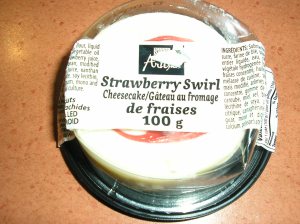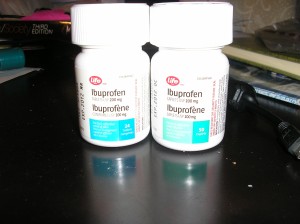Being a French student in Vancouver gives you several opportunities to improve your English vocabulary because most of the things you can buy have bilingual labels.
However, some of these labels tend to leave me totally puzzled and/or amused.
For example, I bought this Cheesecake in Subway last Saturday night:

The English label says : “Strawberry Swirl Cheesecake” and the French one reads : “Gâteau au fromage de fraise”. The problem here is that you can, logically translate “cheese cake” by “gâteau au fromage” but their is something else imply in the French wording: this is a cake but made out of cheese. The real ‘problem’ lies in the fact that the label indicated strongly that the cheese used to make the cake was made out of Strawberries ( and the swirl information totally disappeared).

The left bottle says : “24 Tablets” translated by “24 comprimés”. The problem is on the second bottle. It reads on the same area :”50 Caplets” and it is not translated. And when they refer to this kind of pills, they call them “caplets” in English and French. Well, it gives you the opportunity to deepen your investigation of the shape of your pills, don’t be fooled Tablets and Caplets are not the same:
Meds-Placebo


Salut Elsa! En effet, je suis moi aussi surpris de voir un gâteau au fromage de fraises! Je veux dire, j’aime bien le fromage au lait cru, ou le fromage de chèvre… Mais le fromage de fraises, ça, par contre, j’ai encore jamais essayé!
Dis-moi, co-Franco, tu viens à Montréal un de ces quatre? 😉
Philippe
C’est une erreur de syntaxe: ils auraient dû écrire: gâteau au fromage ET à la fraise. Sachant qu’en français, le cheesecake se traduit par… cheesecake! ou gâteau au fromage blanc.
Les caplets sont traduits en français par: comprimés oblongs (et sécables lorsqu’ils le sont) mais ça fait sûrement beaucoup trop de lettres sur l’étiquette.
Le summum, c’est la traduction de notice d’appareil électroménager fabriqué dans un pays où la main d’oeuvre n’est pas chère. La comprendre demande un QI supérieur et de grandes capacités imaginatives.
Plus intéressante est la question de ce que l’on s’autorise à dire dans une langue étrangère. Pour ma part, j’exprime plus facilement mes sentiments que dans ma langue maternelle, comme si cela portait moins à conséquence…
En tous cas, merci pour ce petit clin d’oeil, car il pleut des chats et des chiens ici aujourd’hui!
Bisous.
Cupule